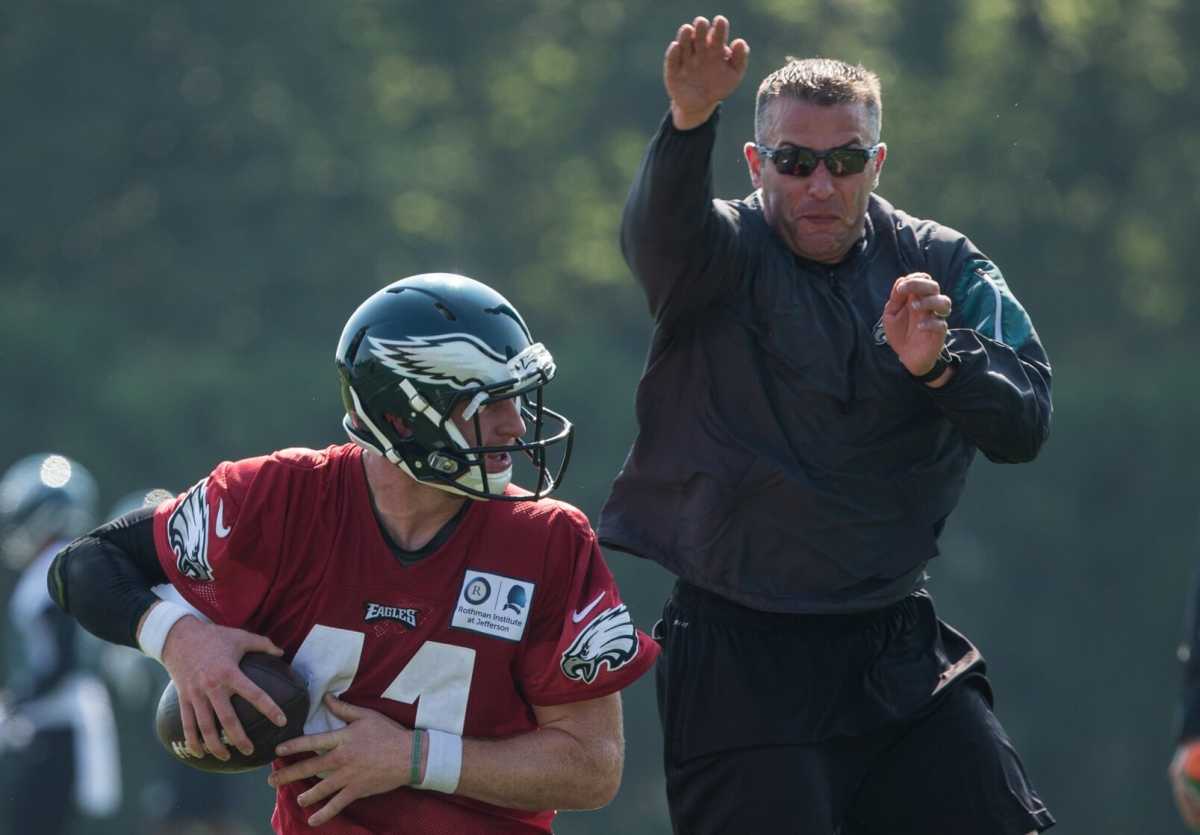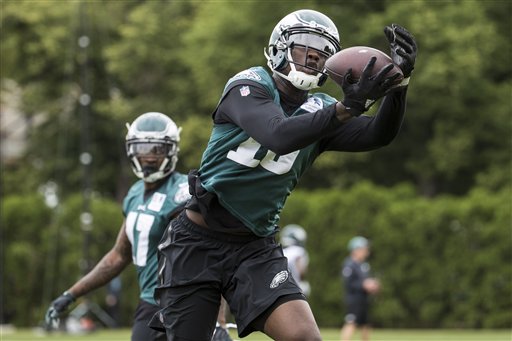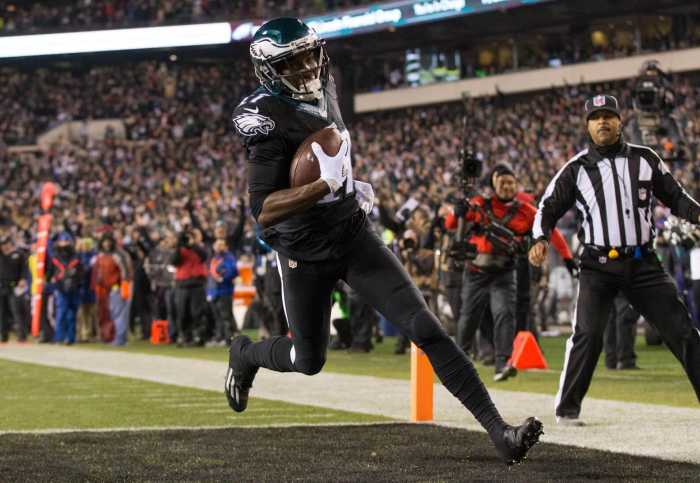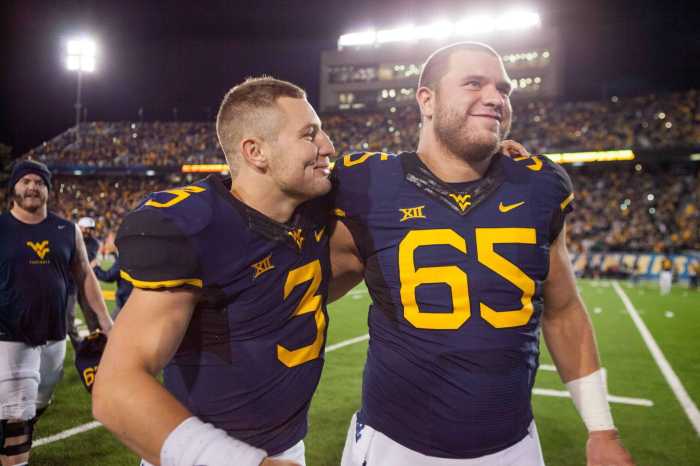When it comes to rebuilding an NFL Franchise, there’s always one common ingredient that is simply vital if it is to be successful. If you have it, the flowchart moves onto the next stage…but if you don’t, the pressures of a modern day NFL can often spark a vicious cycle. That ingredient is of course, a franchise quarterback.
The Eagles were bold in their intentions last year, moving up in the draft to select North Dakota State’s Carson Wentz. After sending Sam Bradford to the Vikings to recoup their first round pick given up for Wentz, the Birds have been set on ensuring that they surround the young gunslinger with talent. 2016 may go down as a year of testing the water and development…but it may turn out to be one of the most important season’s Carson Wentz will endure.
As the Eagles began to surround Wentz with perimeter playmakers this offseason, the phrase “build from the ball out” had become synonymous with the franchise. Isaac Seumalo and Halapoulivaati Vaitai were both instrumental in the sustainability of pass protection last year, as was franchise right guard Brandon Brooks, and versatile lineman Stefen Wisniewski. The team had fortified the trenches to keep their young signal-caller upright. The truth is, building from the ball out may not be glamorous when structuring a new direction, but it works. Just ask the Oakland Raiders.
In the last three year’s, the Raiders have gone from a 3-13 team, to their first playoff berth since 2002. A feat that could have been much greater if it was not for the injury to MVP candidate, quarterback Derek Carr. So how did the Raiders become so good so quickly? The answers resonate more with the Eagles than you may think.
In fact, the secret formula jumps off the screen when you look at Derek Carr’s first three years in the league. 
2014 was a big year for the Raiders. Although they struggled woefully, the rebuilding direction was clear. Without a true number one receiving threat, the team simply had to try and balance their offense…and that all started in the trenches. Oakland would bring in one of the finest left tackles in the league in Donald Penn, alongside Austin Howard and Keith Boothe, cementing their vision to build a fortress around their new prized quarterback. But after taking Carr in the second round, the Raiders would sprinkle one more ingredient into the offensive line, Gabe Jackson. Allowing some of their own more expensive options to walk, the Raiders wanted to get younger, cheaper, and more scheme-efficient in the trenches.
One year, 21 touchdowns and 12 interceptions later, it was clear that teams were wrong to sleep on Carr…so with a relatively strong line in place, it was time to ensure every other aspect of the offense would enrich the performances of the young stud. Raiders fans wouldn’t have to wait long, with Oakland snagging prized free agent WR Michael Crabtree. While it seemed as though he may be Carr’s go-to option right out of the gate, the team would then draft Alabama wideout, Amari Cooper, with the fourth overall pick. With 3,463 yards and 31 touchdowns to his name as a member of the Crimson Tide, Cooper looked primed to come in and immediately give Carr some much needed reliability. Just like that, the Raiders had a proven star on the outside along with a rookie touted to earn a similar reputation…are you drawing the dots yet?
After an impressive rookie season from Carson Wentz, the Eagles went out and bought in both Alshon Jeffery and Torrey Smith in an attempt to end the offenses receiving woes. Unlike the Raiders however, the Eagles offensive line had already taken shape…but we’ll get to that shortly.
Heading into year two, the Raiders had some more pieces to align. Firstly, they bought in Bill Musgrave as their new offensive coordinator, who had previously spent time as a QB coach in Philly. Before any of this however, it was star center, Rodney Hudson who was the talk of free agency after signing with the Raiders to compliment second year guard, Gabe Jackson. Austin Howard moved to right tackle…and just like that, the Raiders had a dominant offensive line.
However, the real value of the line was highlighted in Carr’s second season. While his attempts went down and completions rose along with a spike in touchdowns due to the new weapons, he was sacked a total of 31 times. The reason behind this? Rodney Hudson fell victim to an injury before Austin Howard suffered the same fate. As a result, Latavius Murray’s YPC dropped by an average of over 1.5 yards in his final eight games…with the pressure falling on the Raiders quarterback to use his athleticism and get them out of some tough spots.
Last season saw the Eagles go 5-1 with Lane Johnson starting at right tackle…and without him, well, there were some embarrassing losses, poor rushing performances and a trial by fire for Halapoulivaati Vaitai. The value of depth along the trenches was amplified for the Eagles, with the likes of former Raider, Stefen Wisniewski, Allen Barbre, and Jason Peters all having vital roles to play.
With 2016 on the horizon, the Raiders added the final piece of their offensive line puzzle, signing Kelechi Osemele to cement continuity along the offensive front. What followed was simply stunning. Osemele didn’t give up a single sack last year, allowing just 11 QB pressures all year (per PFF), while Carr was sacked just 16 times…nearly halving the total from 2014. Another total that was halved was his interceptions, while his completion percentage continued to rise.
While the Raiders rebuilding plan doesn’t mirror the Eagles pound-for-pound, nothing ever will due to so many differing factors. However, you can see the pattern in trying to solidify the trenches before adding stars outside and then establishing continuity. For the Eagles, signing Lane Johnson and Zach Ertz to long-term extensions last offseason before re-signing Stefen Wisniewski and extending Jason Peters this offseason has given the Eagles some concrete options inside during the most crucial year’s in Wentz’s development.
The ties to Oakland don’t just end with motive however. As aforementioned, the Raiders signed former Eagles QB coach Bill Musgrave in 2015, but the Eagles would reciprocate the notion, signing former Raiders QB Coach, John DeFilippo. DeFilippo was an integral part of Carr’s early growth, so injecting that formula into the coaching tree in Philly made perfect sense. The Eagles would then go and sign the quarterback who has backed up and mentored Derek Carr ever since he entered the league, Matt McGloin. It’s safe to assume that this is anything but a coincidence.
The Eagles were in a slightly different spot to Oakland, having to scour the wreckage Chip Kelly left behind before committing to a new era. It would be silly to assume Wentz follows the same path as Derek Carr in terms of production, but it’s not hard to imagine. What’s key to note is how much Carr’s numbers flourished once a solid receiving corps and dominant offensive line were finally in place last year. It’s that same scenario that Carson Wentz will look to reap the rewards from in 2017.
Amari Cooper’s 1,000 yard rookie season was supported by Michael Crabtree putting up 922 yards and leading the team in touchdowns in 2015, before the duo would both eclipse the 1,000 yard mark one year later. Whether or not the Eagles wideouts can amass that kind of production remains to be seen, but with a focus on the trenches now seeing the same group of guys aim to keep their quarterback upright in 2017, the future is certainly bright for Wentz.
While both paths intertwined at seemed to overlap at different times, the overall destination is the same for both the Eagles and the Raiders. A franchise quarterback being protected by some of the best cost/production linemen in the league and surrounded by some dominant outside talent. It’s a hard formula to master, just ask the Indianapolis Colts, Jacksonville Jaguars, Chicago Bears, or 2015 Miami Dolphins.
What’s even more interesting is that fire meets fire on Christmas Day, when the Eagles host Oakland during what could be a pivotal regular season game. The similarities on Defense are also astounding, but that’s another article for another day. But if there’s one thing we can take from this, it’s that the overall vision of the Eagles and mindset behind each and every offseason move is clear and concise. Nothing is rushed and very little is risked. Football is won and lost in the Trenches. If you were to ask the 4-12 Philadelphia Eagles before Chip Kelly’s arrival, or the 3-13 Oakland Raiders of 2014…I’m sure they’d nod in agreement. For the Eagles and Raiders, an exciting new era is about to unfold…and it’s one that could see both young quarterbacks one day face on the grandest stage of all.
Mandatory Credit: Bill Streicher-USA TODAY Sports





























